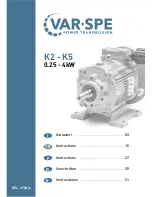
Manual for High Voltage Process Performance Motors
Maintenance - 65
3BFP 000 063 R0101 REV D
7.6.6 The polarization index
For the polarization index test the insulation resistance is measured after the voltage has been
applied for 15 seconds and 1 minute (or 1 minute and 10 minutes). The polarization index test is
less dependent on the temperature than the insulation resistance. When the winding temperature
is below 50ºC (122ºF), it may be considered independent of temperature. High temperatures can
cause unpredictable changes in the polarization index, therefore the test should not be used at
temperatures above 50ºC (122ºF).
Dirt and humidity accumulating in the winding normally reduces the insulation resistance, and
the polarization index, as well as their dependence on temperature. Thus, the line in Figure 7-2
Correlation between the insulation resistance and the temperature becomes less steep.
Windings with open creepage distances are very sensitive to the effects of dirt and humidity.
There are several rules for determining the lowest acceptable value with which the machine can
be safely started. For the polarization index (PI), the values usually range between 1 and 4.
Values close to 1 indicate that the windings are humid and dirty.
The minimum PI value for class F stator windings is more than 2.
NOTE: If the insulation resistance of the winding is in the range of several thousands of M
Ω
,
the polarization index is not a meaningful criterion of the condition of the insulation,
and it can be disregarded.
7.6.7 Other maintenance operations
Usually, ABB-made winding are trouble free and in addition to periodical monitoring they
require only occasional cleaning and drying as described above. If extraordinary circumstances
occur and other maintenance is required, it is best to acquire professional help. The ABB After
Sales organization is eager to assist in questions regarding maintenance of electrical machine
winding, for contact information see Chapter 9.1.5 After Sales contact information.
7.7 Repairs, disassembly and assembly
All the actions related to repairs, disassembly and assembly should be done by trained service
personnel. For more information, please contact After Sales, see Chapter 9.1.5 After Sales
contact information.
NOTE: Machines in hazardous areas must only be serviced by repair shops qualified and
authorized by ABB.
⎟⎟
⎠
⎞
⎜⎜
⎝
⎛
=
min
1
min
10
15
min
1
R
R
or
R
R
PI
s
















































